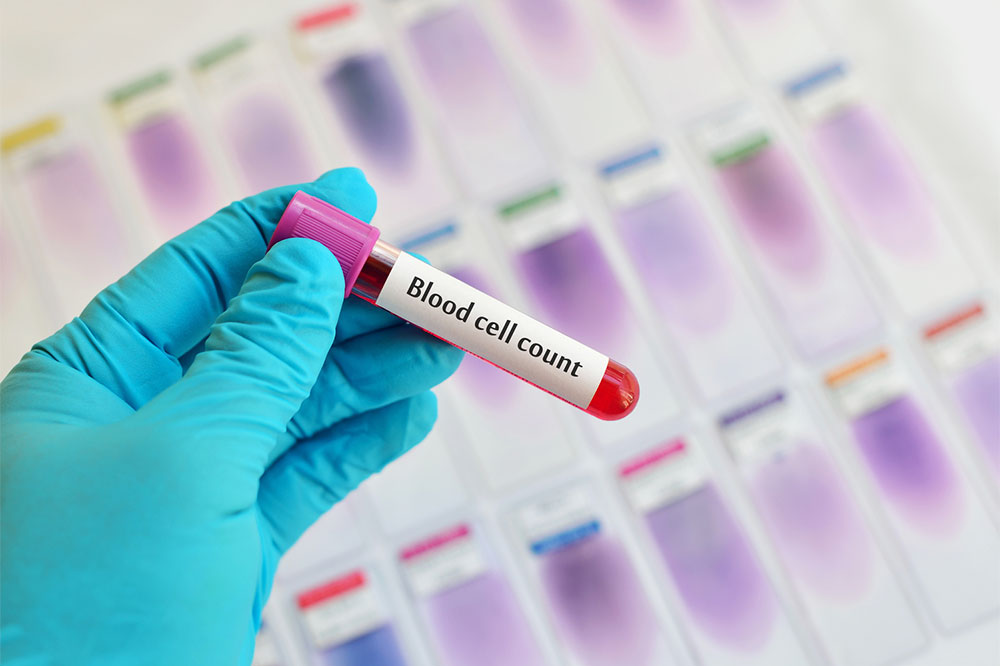Understanding Different Aspects of Blood Cell Counts
A measure of red blood cells, white blood cells, and platelets constitutes the blood cell count test. In addition, the amount of hemoglobin and hematocrit are assessed. Around thirty percent of the global population, or more than two billion individuals, suffer from illnesses related to a low blood cell count. This article discusses in detail what blood count is, the symptoms and causes of low blood cell count, and how to prevent it.

Why do you need to check the blood cell count?
A blood cell count can aid in the diagnosis process and be used to monitor numerous diseases. This test is synonymous with CBC, complete blood count, and total blood count. Blood is collected by inserting a needle into a vein, then removing the needle and allowing the blood to flow into a tube.
The blood sample is transported to a laboratory for analysis, where the quantity of platelets, red blood cells, and white blood cells is determined. The complete blood count (CBC) test includes screening, diagnostic, and monitoring tests for various diseases.
Causes of low white blood cell count
The spongy substance located inside some of your larger bones is known as the bone marrow, and it is in this area that white blood cells are produced. The most common causes of a low white blood cell count are as follows:
Disorders of the bone marrow
Low WBC counts are commonly connected with problems in the bone marrow. The ability of your bone marrow to create white blood cells (WBCs) can be significantly affected by exposure to benzene and pesticides, as well as cancer treatments, such as chemotherapy and radiation.
Autoimmune disorders
Autoimmune disorders such as lupus and rheumatoid arthritis can majorly cause low white blood cell count.
Infections
Viruses can affect the bone marrow, decreasing WBC numbers for an extended period. When you have a severe sickness, such as one that affects your blood, your white blood cells may be depleted faster than they can be replaced.
Radiation exposure
Radiation therapy is a cancer treatment that may lead to a decreased white blood cell count in certain cases.
Symptoms of low white blood cell count
Fever
Chills
Lesions of the mouth
Cough
Having difficulty with breathing
Abdominal or rectal pain
How to prevent a low white blood cell count?
While there is no way to prevent the probability of developing certain diseases definitely, it is advisable to follow some basic steps such as:
Maintain a clean and hygienic environment. For example, you should wash your hands before cooking and after using the restroom to prevent the transmission of germs
Take precautions when interacting with animals, especially strays
Before consuming food, especially meats and seafood, you should ensure that it has been well prepared and is not raw
Maintain a safe distance from individuals who are sick with any contagious illness
Treatment for low white blood cell count
If the number of white blood cells is lower than required, doctors will suggest a treatment plan on the basis of the underlying cause. In most cases, it may involve the use of antibiotics.
Causes of low red blood cell count
Anemia is a disease in which the blood cannot deliver sufficient oxygen to the body. Sometimes, it is referred to as “low hemoglobin,” “low hgb,” or “low red blood cell count.” The most prevalent cause of anemia is an iron deficiency in the body. This particular form of anemia is known as iron-deficiency anemia.
The following factors contribute to low red blood cell count:
A vitamin B12 shortage
Folate, commonly known as folic acid, may be lacking in your diet, or your body may be unable to utilize folic acid effectively
Birth-related blood disorders like sickle cell anemia or thalassemia
Fast red blood cell degeneration
Bleeding due to conditions such as ulcers, hemorrhoids, or gastritis
Symptoms of low red blood cell count
Fatigue
Weakness
Dizziness
Headache
Irritability
Unease and respiratory difficulties (severe cases)
Chest pains (severe cases)
Treatments for low red blood cell count
The treatments for iron-deficiency anemia are:
Daily administration of oral iron supplementation
Transfusion of red blood cells
Beta-thalassemia and sickle cell anemia are inherited disorders that may necessitate a bone marrow transplant
Additional treatment options may include erythropoietin injections and oral or intravenous iron supplementation (EPO). EPO is a hormone that stimulates the formation of red blood cells in the bone marrow.
Diagnosis of low blood cell count
The doctor will order a complete blood count blood test to determine whether or not the patient has an abnormally low white blood cell count. Suppose a patient has specific conditions, such as an infection or a problem with the immune system; the doctor may frequently order a complete blood count test to monitor the patient’s condition. Your doctor can narrow down the list of potential conditions based on further information from the test. Your primary care physician may recommend you consult a hematology expert for additional testing.
Conclusion
Blood cells are vital in delivering oxygen and other substances throughout your body. But when your body generates too few or too many, it can lead to additional disorders. It’s crucial to talk to your physician in case you experience any of the above-mentioned symptoms. Note that these symptoms overlap with those of several conditions, so you may not have an issue with your blood cell count.